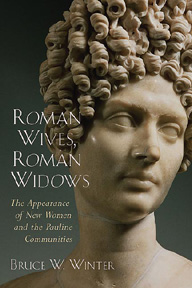Multimedia • Reference • Religion • Travel |
 Roman Wives, Roman Widows: The Appearance of New Women and the Pauline Communities Bruce W. Winter
Description From The Publisher: In Roman law you were what you wore. This legal principle became highly significant because, beginning in the first century A.D., a “new” kind of woman emerged across the Roman empire — a woman whose provocative dress and sometimes promiscuous lifestyle contrasted starkly with the decorum of the traditional married woman. What a woman chose to wear came to identify her as either “new” or “modest.” Augustus legislated against the “new” woman. Philosophical schools encouraged their followers to avoid embracing her way of life. And, as this fascinating book demonstrates for the first time, the presence of the “new” woman was also felt in the early church, where Christian wives and widows were exhorted to emulate neither her dress code nor her conduct. Using his extensive knowledge both of the Graeco-Roman world and of the New Testament writings, Bruce Winter shows how changing social mores among women impacted the Pauline communities. This helps to explain the controversial texts on marriage veils in 1 Corinthians, instructions in 1 Timothy regarding dress code and the activities of young widows, and exhortations in Titus for older women to call new wives “back to their senses” regarding their marriage and family responsibilities. Based on a close investigation of neglected literary and archaeological evidence, Roman Wives, Roman Widows makes groundbreaking contributions to our understanding of first-century women, including their participation in public life as lawyers, magistrates, and political figures, which in turn affected women’s ministry in the Pauline communities. Reviews Bruce Winter draws on a wide range of classical and Christian sources to illuminate both Roman society and early Christian society. Placing New Testament texts in the wider social and cultural setting of the Mediterranean in early imperial Roman times, he makes a highly readable contribution to recent scholarship that is bringing about closer integration of Roman and early Christian studies, to the benefit of both. —Beryl Rawson
Reader's Index Send us your favorite quotes or passages from this book. About the Author Table of Contents Customer Reviews Write your own online review. Look for Similar Books by Subject | |||||||
Copyright ©1996-2009 CenturyOne Bookstore. All Rights Reserved. All prices subject to change and given in U.S. dollars. Your purchase from CenturyOne.com will assist the CenturyOne Foundation in providing funding for various archaeological and research projects which seek to provide more information about the period of the First Century C.E., the origins of Christianity and the world of the Bible in general. All materials contained in http://www.centuryone.com are protected by copyright and trademark laws and may not be used for any purpose whatsoever other than private, non-commercial viewing purposes. Derivative works and other unauthorized copying or use of stills, video footage, text or graphics is expressly prohibited. |

